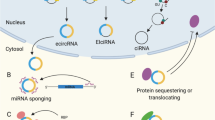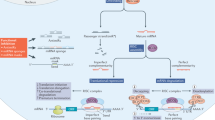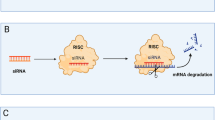Abstract
Suppressing the expression of toxic genes through RNAi holds great promise for the treatment of human disease. Allele-specific approaches have now been used to silence dominant toxic genes implicated in several neurological disorders. Here, we review strategies used to achieve allele-specific silencing in light of recent developments in the field of RNAi biology. In particular, new insights into siRNA and miRNA processing may be used to improve efficiency and specificity of RNAi therapy. We further discuss steps that can be taken to maximize the therapeutic benefits of this powerful technology.
This is a preview of subscription content, access via your institution
Access options
Subscribe to this journal
Receive 12 print issues and online access
$259.00 per year
only $21.58 per issue
Buy this article
- Purchase on Springer Link
- Instant access to full article PDF
Prices may be subject to local taxes which are calculated during checkout
Similar content being viewed by others
References
Xia H, Mao Q, Eliason EL, Harper SQ, Martins IH, Orr HT et al. RNAi suppresses polyglutamine-induced neurodegeneration in a model of spinocerebellar ataxia. Nat Med 2004; 10: 816–820.
Rodriguez-Lebron E, Denovan-Wright EM, Nash K, Lewin AS, Mandel RJ . Intrastriatal rAAV-mediated delivery of anti-huntingtin shRNAs induces partial reversal of disease progression in R6/1 Huntington's disease transgenic mice. Mol Ther 2005; 12: 618–633.
Harper SQ, Staber PD, He X, Eliason SL, Martins IH, Mao Q et al. RNA interference improves motor and neuropathological abnormalities in a Huntington's disease mouse model. Proc Natl Acad Sci USA 2005; 102: 5820–5825.
Raoul C, Abbas-Terki T, Bensadoun JC, Guillot S, Haase G, Szulc J et al. Lentiviral-mediated silencing of SOD1 through RNA interference retards disease onset and progression in a mouse model of ALS. Nat Med 2005; 11: 423–428.
Ralph GS, Radcliffe PA, Day DM, Carthy JM, Leroux MA, Lee DC et al. Silencing mutant SOD1 using RNAi protects against neurodegeneration and extends survival in an ALS model. Nat Med 2005; 11: 429–433.
Khvorova A, Reynolds A, Jayasena SD . Functional siRNAs and miRNAs exhibit strand bias. Cell 2003; 115: 209–216.
Schwarz DS, Hutvagner G, Du T, Xu Z, Aronin N, Zamore PD . Asymmetry in the assembly of the RNAi enzyme complex. Cell 2003; 115: 199–208.
Liu J, Carmell MA, Rivas FV, Marsden CG, Thomson JM, Song JJ et al. Argonaute2 is the catalytic engine of mammalian RNAi. Science 2004; 305: 1437–1441.
Fire A, Xu S, Montgomery MK, Kostas SA, Driver SE, Mello CC . Potent and specific genetic interference by double-stranded RNA in Caenorhabditis elegans. Nature 1998; 391: 806–811.
Mendell JT . MicroRNAs: critical regulators of development, cellular physiology and malignancy. Cell Cycle 2005; 4: 1179–1184.
Murchison EP, Partridge JF, Tam OH, Cheloufi S, Hannon GJ . Characterization of Dicer-deficient murine embryonic stem cells. Proc Natl Acad Sci USA 2005; 102: 12135–12140.
Denli AM, Tops BB, Plasterk RH, Ketting RF, Hannon GJ . Processing of primary microRNAs by the microprocessor complex. Nature 2004; 432: 231–235.
Bartel DP . MicroRNAs: genomics, biogenesis, mechanism, and function. Cell 2004; 116: 281–297.
Elbashir SM, Martinez J, Patkaniowska A, Lendeckel W, Tuschl T . Functional anatomy of siRNAs for mediating efficient RNAi in Drosophila melanogaster embryo lysate. EMBO J 2001; 20: 6877–6888.
Haley B, Zamore PD . Kinetic analysis of the RNAi enzyme complex. Nat Struct Mol Biol 2004; 11: 599–606.
Ding H, Schwarz DS, Keene A, Affar el B, Fenton L, Xia X et al. Selective silencing by RNAi of a dominant allele that causes amyotrophic lateral sclerosis. Aging Cell 2003; 2: 209–217.
Miller VM, Gouvion CM, Davidson BL, Paulson HL . Targeting Alzheimer's disease genes with RNA interference: an efficient strategy for silencing mutant alleles. Nucleic Acids Res 2004; 32: 661–668.
Gonzalez-Alegre P, Miller VM, Davidson BL, Paulson HL . Toward therapy for DYT1 dystonia: allele-specific silencing of mutant TorsinA. Ann Neurol 2003; 53: 781–787.
Miller VM, Xia H, Marrs GL, Gouvion CM, Lee G, Davidson BL et al. Allele-specific silencing of dominant disease genes. Proc Natl Acad Sci USA 2003; 100: 7195–7200.
Gaspar C, Lopes-Cendes I, Hayes S, Goto J, Arvidsson K, Dias A et al. Ancestral origins of the Machado–Joseph disease mutation: a worldwide haplotype study. Am J Hum Genet 2001; 68: 523–528.
Reiner A, Dragatsis I, Zeitlin S, Goldowitz D . Wild-type huntingtin plays a role in brain development and neuronal survival. Mol Neurobiol 2003; 28: 259–276.
Almqvist E, Spence N, Nichol K, Andrew SE, Vesa J, Peltonen L et al. Ancestral differences in the distribution of the delta 2642 glutamic acid polymorphism is associated with varying CAG repeat lengths on normal chromosomes: insights into the genetic evolution of Huntington disease. Hum Mol Genet 1995; 4: 207–214.
Ozelius LJ, Hewett JW, Page CE, Bressman SB, Kramer PL, Shalish C et al. The early-onset torsion dystonia gene (DYT1) encodes an ATP-binding protein. Nat Genet 1997; 17: 40–48.
Breakefield XO, Kamm C, Hanson PI . TorsinA: movement at many levels. Neuron 2001; 31: 9–12.
Gonzalez-Alegre P, Paulson HL . Aberrant cellular behavior of mutant torsinA implicates nuclear envelope dysfunction in DYT1 dystonia. J Neurosci 2004; 24: 2593–2601.
Lipscombe D . Neuronal proteins custom designed by alternative splicing. Curr Opin Neurobiol 2005; 15: 358–363.
Parker JS, Roe SM, Barford D . Crystal structure of a PIWI protein suggests mechanisms for siRNA recognition and slicer activity. EMBO J 2004; 23: 4727–4737.
Song JJ, Smith SK, Hannon GJ, Joshua-Tor L . Crystal structure of Argonaute and its implications for RISC slicer activity. Science 2004; 305: 1434–1437.
Tomari Y, Matranga C, Haley B, Martinez N, Zamore PD . A protein sensor for siRNA asymmetry. Science 2004; 306: 1377–1380.
Parker JS, Roe SM, Barford D . Structural insights into mRNA recognition from a PIWI domain-siRNA guide complex. Nature 2005; 434: 663–666.
Ma JB, Yuan YR, Meister G, Pei Y, Tuschl T, Patel DJ . Structural basis for 5′-end-specific recognition of guide RNA by the A. fulgidus Piwi protein. Nature 2005; 434: 666–670.
Vermeulen A, Behlen L, Reynolds A, Wolfson A, Marshall WS, Karpilow J et al. The contributions of dsRNA structure to Dicer specificity and efficiency. Rna 2005; 11: 674–682.
Miyagishi M, Taira K . U6 promoter-driven siRNAs with four uridine 3′ overhangs efficiently suppress targeted gene expression in mammalian cells. Nat Biotechnol 2002; 20: 497–500.
Cullen BR . Transcription and processing of human microRNA precursors. Mol Cell 2004; 16: 861–865.
Zeng Y, Cullen BR . Efficient processing of primary microRNA hairpins by Drosha requires flanking nonstructured RNA sequences. J Biol Chem 2005; 280: 27595–27603.
Zeng Y, Cai X, Cullen BR . Use of RNA polymerase II to transcribe artificial microRNAs. Methods Enzymol 2005; 392: 371–380.
Morrissey DV, Lockridge JA, Shaw L, Blanchard K, Jensen K, Breen W et al. Potent and persistent in vivo anti-HBV activity of chemically modified siRNAs. Nat Biotechnol 2005; 23: 1002–1007.
Manoharan M . RNA interference and chemically modified small interfering RNAs. Curr Opin Chem Biol 2004; 8: 570–579.
Eckstein F . Small non-coding RNAs as magic bullets. Trends Biochem Sci 2005; 30: 445–452.
Check E . A crucial test. Nat Med 2005; 11: 243–244.
Soutschek J, Akinc A, Bramlage B, Charisse K, Constien R, Donoghue M et al. Therapeutic silencing of an endogenous gene by systemic administration of modified siRNAs. Nature 2004; 432: 173–178.
Song E, Zhu P, Lee SK, Chowdhury D, Kussman S, Dykxhoorn DM et al. Antibody mediated in vivo delivery of small interfering RNAs via cell-surface receptors. Nat Biotechnol 2005; 23: 709–717.
Author information
Authors and Affiliations
Corresponding author
Rights and permissions
About this article
Cite this article
Rodriguez-Lebron, E., Paulson, H. Allele-specific RNA interference for neurological disease. Gene Ther 13, 576–581 (2006). https://doi.org/10.1038/sj.gt.3302702
Received:
Revised:
Accepted:
Published:
Issue Date:
DOI: https://doi.org/10.1038/sj.gt.3302702
Keywords
This article is cited by
-
Gedunin Degrades Aggregates of Mutant Huntingtin Protein and Intranuclear Inclusions via the Proteasomal Pathway in Neurons and Fibroblasts from Patients with Huntington’s Disease
Neuroscience Bulletin (2019)
-
Genetics, Mechanisms, and Therapeutic Progress in Polyglutamine Spinocerebellar Ataxias
Neurotherapeutics (2019)
-
Influence of mismatched and bulged nucleotides on SNP-preferential RNase H cleavage of RNA-antisense gapmer heteroduplexes
Scientific Reports (2017)
-
RNAi-mediated Gene Silencing of Mutant Myotilin Improves Myopathy in LGMD1A Mice
Molecular Therapy - Nucleic Acids (2014)
-
A novel measurement of allele discrimination for assessment of allele-specific silencing by RNA interference
Molecular Biology Reports (2014)



